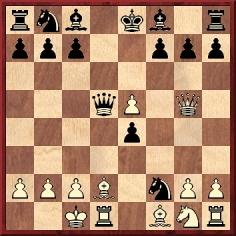
Edward Winter
Regarding the famous Réti v Tartakower Qd8+ combination (i.e. in the game 1 e4 c6 2 d4 d5 3 Nc3 dxe4 4 Nxe4 Nf6 5 Qd3 e5 6 dxe5 Qa5+ 7 Bd2 Qxe5 8 O-O-O Nxe4 9 Qd8+ Kxd8 10 Bg5+ Kc7 11 Bd8 mate), several precedents are known, four instances being mentioned by Richard Forster on page 333 of the anthology Heroic Tales (Milford, 2002). Here is another case:
Isaac Edward Orchard – W.E. Orchard1 e4 e5 2 d4 d5 3 dxe5 dxe4 4 Qh5 Qd5 5 Bd2 Nf6 6 Qg5 Ng4 7 O-O-O Nxf2

8 Bc4 Qxc4 and White forced mate in three with 9 Qd8+ Kxd8 10 Bg5+ Ke8 11 Rd8 mate.
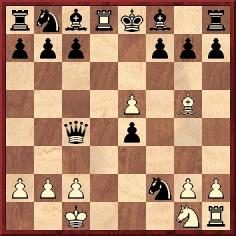
Source: American Chess Review, July 1886, page 9.
(2908)
‘Probably the most famous of all miniature games’, wrote Irving Chernev (1000 Best Short Games of Chess, page 18) about Réti v Tartakower, Vienna, 1910. The description is debatable, not least because on page 213 Chernev quoted favourably Marshall’s statement that Morphy’s opera brilliancy was ‘the most famous game of all time’.
Although the Réti game has lost much of its impact because of the various anticipations of the queen sacrifice, we wonder about the circumstances in which it was played, particularly since it is hard to find in magazines of the time. It was, though, published on page 4 of Schachjahrbuch für 1910. II. Teil by L. Bachmann (Ansbach, 1911), with the finish 10 Bg5+ Resigns. When Tartakower gave the score on pages 81-82 of A Breviary of Chess (calling 11 Bd8 ‘a splendid mate’ and declaring that ‘nothing could better illustrate the power of a double check’), he merely put ‘Played in Vienna, 1910’. On page 17 of his earlier book Schachmethodik (Berlin, 1928 and 1929) Tartakower called it a ‘Freipartie’, i.e. a casual game. The term ‘lightning game’ was used on page 23 of The Chess Player’s Bedside Book by R. Bott and S. Morrison (London, 1966), but on what grounds?(3136)
Peter Anderberg reports that the game was published by Georg Marco in his chess column on page 10 of Neues Wiener Tagblatt, 1 April 1910, with the finish ‘10 Bg5+ Resigns’. The game was played for a small stake (ten crowns) and at a time-limit of 15 moves per hour. Below is Marco’s introduction to the game:
‘Als ein Unikum aber muss die nachstehende Partie gelten, in der sich Dr. S. Tartakower, einer der glänzendsten Repräsentanten der Gegenwart, vom Jungmeister Richard Réti in zehn Zügen überrumpeln liess. Dabei muss betont werden, dass die Partie nicht etwa im Eilzugstempo – “Zug-Zug” –, sondern mit vollem Ernst, mit Uhrenkontrolle (15 Züge per Stunde), um einen Einsatz von 10 K. gespielt wurde. Natürlich hat Dr. Tartakower in der nächsten Partie Satisfaktion gesucht und – wie wir zur Beruhigung seiner Freunde hinzufügen – auch gefunden.’
(3151)
Tartakower also published the game at the end of his tribute article to Réti on pages 212-214 of Kagans Neueste Schachnachrichten, July 1929:

Eduardo Bauzá Mercére (New York, NY, USA) has found a similar finish in the game below:
C.E. Hewlett – F.M. Young1 e4 e5 2 f4 exf4 3 Nf3 g5 4 d4 g4 5 Ne5 Qh4+ 6 g3 fxg3 7 Qxg4 g2+ 8 Qxh4 gxh1(Q) 9 Be3 d6 10 Nc3 dxe5 11 O-O-O Qf3 12 Bd2 Bb4 13 dxe5 Bg4
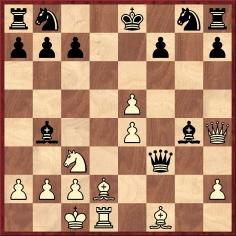
White gave mate in three moves.
Source: Galveston Daily News, 27 April 1890.
(7504)
The four games listed by Richard Forster in Heroic Tales were Maczuski v Kolisch, Paris, 1863; Prince Dadian v N.N., Odessa, 1894; Distl v Roszypal, Prague, 1900; Kaldegg v Zeissl, Vienna, 1903.
For a detailed discussion, with rich source material, on the Maczuski v Kolisch game, see pages 208-209 of Ignaz Kolisch The Life and Chess Career by Fabrizio Zavatarelli (Jefferson, 2015).
An additional game, with the rarity of the (lucky) winner being Black, is shown now from page 4 of the Evening Star (Dunedin), 1 July 1933:
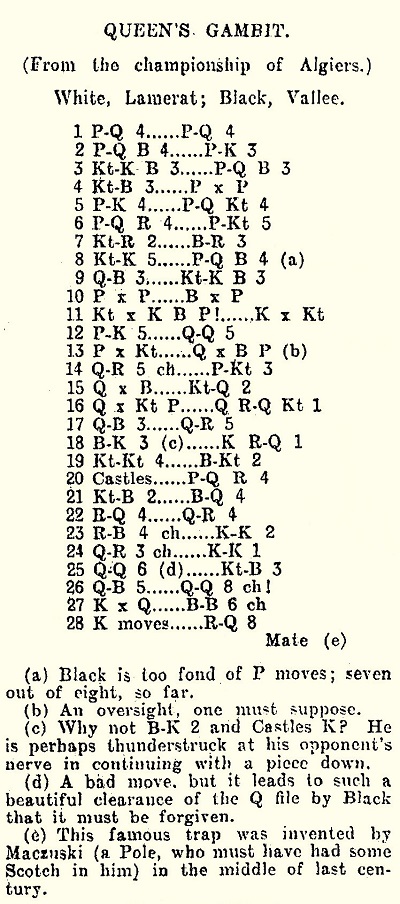
1 d4 d5 2 c4 e6 3 Nf3 c6 4 Nc3 dxc4 5 e4 b5 6 a4 b4 7 Na2 Ba6 8 Ne5 c5 9 Qf3 Nf6 10 dxc5 Bxc5 11 Nxf7 Kxf7 12 e5 Qd4 13 exf6 Qxf6 14 Qh5+ g6 15 Qxc5 Nd7 16 Qxb4 Rab8 17 Qc3 Qh4 18 Be3 Rhd8 19 Nb4 Bb7 20 O-O-O a5 21 Nc2 Bd5 22 Rd4 Qh5 23 Rf4+ Ke7 24 Qa3+ Ke8 25 Qd6 Nf6 26 Qc5
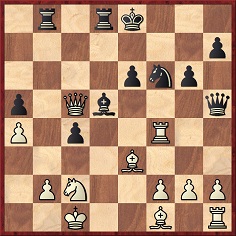
26...Qd1+ 27 Kxd1 Bf3+ 28 K moves Rd1 mate.
More information about the game and the players will be welcome.
A win by Alekhine against ‘Lamerat (champion of Algeria)’ is on page 485 of the October 1935 BCM:
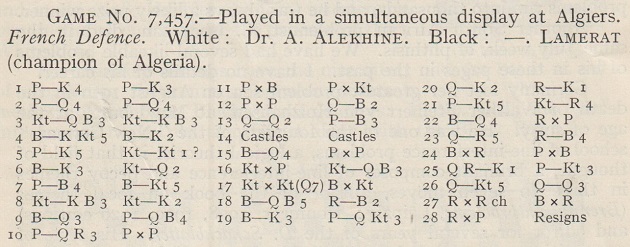
Page 513 of the Skinner/Verhoeven volume on Alekhine specified that the simultaneous exhibition took place in Algiers in December 1934.
In Jeremy Gaige’s Chess Personalia the only entry of potential relevance is for Léonce Lamérat, a problemist who had died in 1933. The Cleveland Public Library has forwarded the announcement of his death on page 258 [sic – Gaige gave ‘358’] of La Stratégie, November 1933:
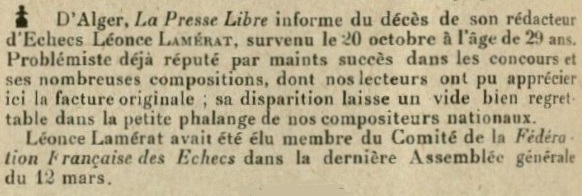
Addition on 6 September 2020:
Alain Pallier (Lauris, France) notes that the problemist Léonce Lamérat had a brother, Henri, who participated in the 1930 French championship in Rouen. As quoted in the tournament report (which included a group photograph) on page 4 of La Liberté, 21 September 1930, Alekhine wrote:
‘Lamérat est la révélation du Championnat de 1930.’
Addition on 10 November 2020:
Mr Pallier has sent us two further links concerning Henri Lamérat (1906-95): material at the Héritage des échecs français and GénéaFrance websites.
See also our feature articles on Richard Réti and Savielly Tartakower.
To the Chess Notes main page.
To the Archives for other feature articles.
Copyright: Edward Winter. All rights reserved.